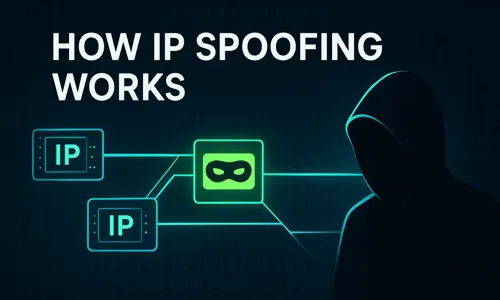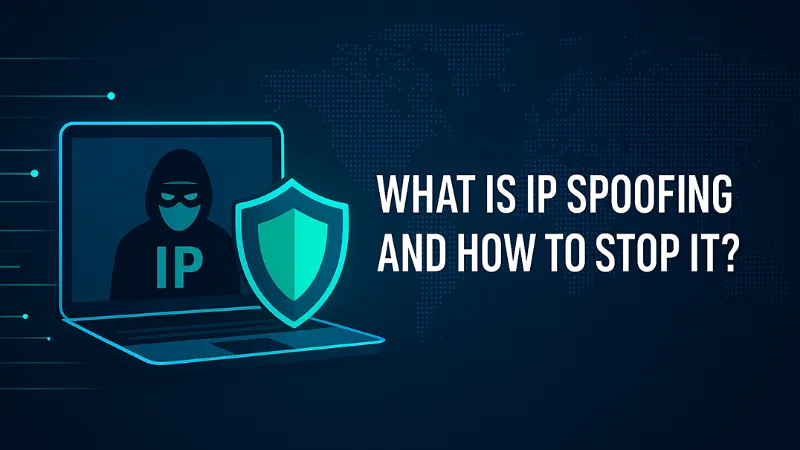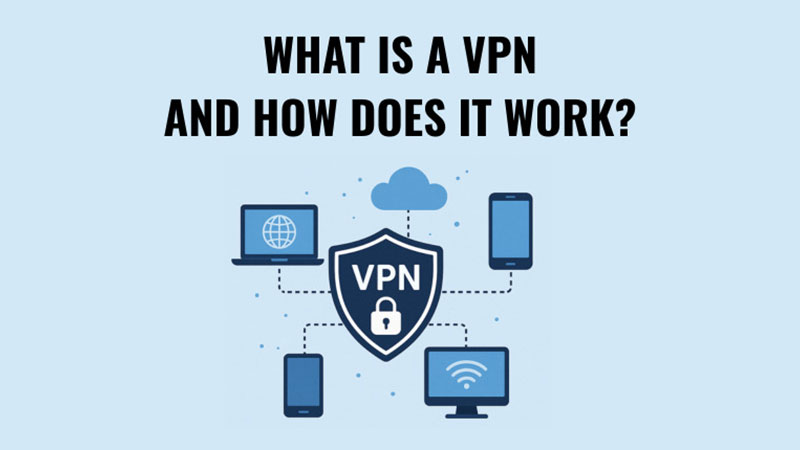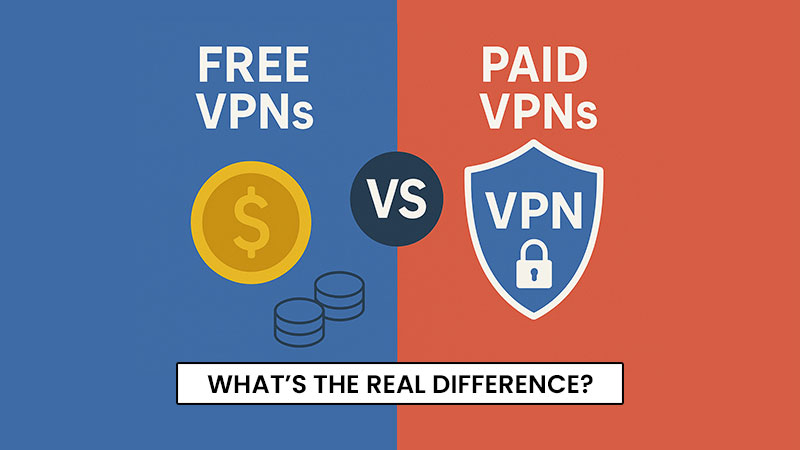Understanding What Is IP Spoofing has become increasingly important for individuals, businesses, and organizations. IP Spoofing is one of the most deceptive and dangerous attack techniques used by cybercriminals to disguise their true identity and manipulate network communications. With the rise of online threats, every internet user is at potential risk of falling victim to an IP spoofing attack. This technique allows attackers to send data packets that appear to come from a trusted or known source, tricking systems and users into believing the connection is legitimate. Whether you’re managing a corporate network, running an online business, or simply browsing the web, learning What Is IP Spoofing and how it works is the first step toward defending your data, maintaining privacy, and ensuring secure communication across the internet.
What Is IP Spoofing?

When we talk about What Is IP Spoofing, we’re referring to a malicious technique used by hackers to deceive systems and users by forging Internet Protocol (IP) addresses. In essence, Internet Protocol Spoofing involves manipulating packet headers so that they appear to originate from a trusted or legitimate source instead of the attacker’s true device. This deception can allow attackers to bypass security systems, steal data, or launch broader cyberattacks such as DDoS or man-in-the-middle assaults.
In simpler terms, IP Spoofing is like someone faking their caller ID before making a phone call. The receiver sees a familiar or trusted number and answers, unaware of the deception. Cybercriminals use the same principle online, altering the source IP address to hide their identity and gain unauthorized access.
The question of What Is Internet Protocol Spoofing is important for network administrators, developers, and everyday users. By understanding that IP Spoofing exploits weaknesses in how internet protocols verify packet sources, organizations can better prepare their defenses. Attackers typically rely on this technique to impersonate a legitimate system, making it easier to infiltrate networks or disrupt normal operations.
When computers communicate over the internet, each data packet includes the sender’s and receiver’s IP addresses. Attackers exploit this by altering the sender’s IP to trick systems into trusting malicious traffic, paving the way for unauthorized access, data manipulation, or service disruptions.
How IP Spoofing Works

Understanding how Internet Protocol spoofing works helps you grasp why it’s so dangerous and how easily it can compromise a network. At its core, IP spoofing takes advantage of how data packets are transmitted across networks using the Internet Protocol (IP). Normally, every packet contains information about where it comes from (source IP) and where it’s going (destination IP). Hackers manipulate this information to deceive the target system.
Here’s a detailed breakdown of the process:
- Packet Creation:
The attacker creates or captures a legitimate data packet using advanced Internet Protocol spoofing tools. These tools allow modification of the packet’s source address so that it appears to originate from a trusted IP. - Deceptive Transmission:
The forged packets are then transmitted to the target network. Because the source IP appears genuine, the system’s firewall or router often accepts the packet without question. - Response Manipulation:
In some cases, the target system responds to the spoofed IP address rather than the attacker’s real one. This can cause confusion, redirect data, or enable further infiltration. - Attack Execution:
Once trust is established, attackers can perform a range of malicious activities – stealing sensitive data, installing malware, or overwhelming a system with fake traffic (as in DDoS attacks).
In many IP spoofing attacks, the hacker’s main goal is not to steal information directly but to use deception to bypass network defenses. Understanding this mechanism is crucial to building resilient network systems.
Common Types of IP Spoofing Attacks
There are several types of IP spoofing attacks, each with its unique goal and impact on network infrastructure:
Denial-of-Service (DoS) and Distributed DoS (DDoS) Attacks
Attackers flood a target server or network with massive amounts of fake traffic. By using spoofed IP addresses, they conceal their identity and make it nearly impossible for defenders to trace the attack’s origin. This leads to server overloads, downtime, and financial losses.
Man-in-the-Middle (MitM) Attacks
In this sophisticated Internet Protocol spoofing attack, hackers insert themselves between two legitimate systems. By intercepting and altering communications, they can eavesdrop on sensitive information, such as login credentials or financial transactions.
Session Hijacking
Here, attackers exploit valid communication sessions by impersonating an authenticated user. Once the spoofed connection is accepted, they can take control of the session, access data, or execute commands.
Network Scanning Evasion
When conducting reconnaissance, attackers use spoofed IP addresses to scan systems and networks while concealing their actual identity. This allows them to map vulnerabilities without triggering alerts or detection systems.
Reflection and Amplification Attacks
In these large-scale attacks, spoofed IPs are used to send requests to multiple servers, which then respond to the spoofed address (the victim). The combined responses overwhelm the target’s bandwidth, causing service disruptions.
How to Detect IP Spoofing

Detecting IP spoofing requires careful monitoring and analysis, as attackers go to great lengths to mask their activities. However, several techniques and tools can help identify suspicious patterns:
- Monitor Unusual Network Traffic: A sudden surge in data packets, high latency, or unusual request patterns can indicate a possible Internet Protocol spoofing attack.
- Analyze Access Logs: Repeated login attempts from unknown IP addresses, inconsistent geolocations, or mismatched device information are red flags.
- Use Intrusion Detection Systems (IDS): Advanced IDS solutions like Snort, Suricata, or Zeek can detect anomalies in packet headers and flag spoofed IPs.
- Implement Packet Analysis: Tools like Wireshark allow administrators to inspect packet-level data and compare source IP information against expected traffic.
- Check Reverse Path Verification: Modern routers can perform reverse path forwarding checks to validate whether packets are coming from legitimate paths.
Early detection plays a critical role in mitigating IP spoofing attacks before they cause widespread harm. Continuous monitoring, logging, and traffic analysis are key defenses.
How to Prevent IP Spoofing

Preventing IP spoofing involves implementing layered security measures that reduce the likelihood of successful attacks. Here are effective strategies for protecting your network:
Implement Packet Filtering
Routers and firewalls should use ingress and egress filtering to block packets with invalid, private, or mismatched source IP addresses. This helps ensure only legitimate traffic enters or leaves your network.
Use Strong Authentication and Encryption
Even if attackers manage to spoof an IP, encryption methods like SSL/TLS and strong multi-factor authentication (MFA) make it nearly impossible for them to access or modify data.
Deploy Anti-Spoofing Technologies
Techniques such as reverse path forwarding (RPF) and access control lists (ACLs) can identify and discard packets with forged IPs before they reach critical systems.
Network Segmentation
Dividing a network into smaller, isolated segments limits the spread of an attack. If one area is compromised, others remain unaffected.
Regularly Update Systems and Firmware
Outdated routers, firewalls, and operating systems often contain vulnerabilities. Keeping all network devices updated ensures they have the latest security patches.
Employee Training and Awareness
Educating staff about cybersecurity practices and the dangers of IP spoofing attacks helps reduce the likelihood of human error leading to security breaches.
Continuous Monitoring and Threat Intelligence
Use advanced analytics and AI-driven monitoring tools to detect patterns, predict threats, and block IP spoofing attacks before they escalate.
By implementing these measures, organizations can significantly minimize the risk of falling victim to Internet Protocol spoofing while strengthening overall network resilience.
FAQs About What Is IP Spoofing and How to Stop It?
Yes. IP spoofing is illegal in most jurisdictions when used for malicious activities such as hacking, fraud, or denial-of-service attacks. However, some cybersecurity professionals use controlled IP spoofing in ethical testing or research environments.
No. While it’s nearly impossible to eliminate IP spoofing entirely, implementing robust security measures – like packet filtering, encryption, and intrusion detection systems – can significantly reduce the risk.
Yes. While businesses are often primary targets, personal computers can also be affected if connected to unsecured networks or if they interact with spoofed traffic online.
Yes. A reliable VPN encrypts your internet traffic and masks your IP address, making it much harder for attackers to spoof or intercept your network communications.
No. IP spoofing targets network-level communication by faking IP addresses, whereas email spoofing manipulates email headers to appear as if messages come from trusted senders. Both, however, are forms of deception used in cyberattacks.







